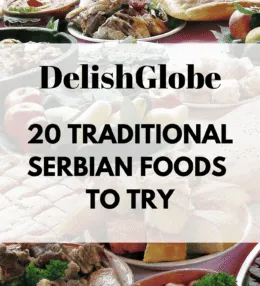Croatian food has a way of surprising you in the most honest and rewarding sense. At first glance, the dishes may seem humble, but behind every slow cooked stew or crisp pastry is a depth of tradition shaped by geography, history, and time. This is a cuisine influenced by both coastal abundance and inland heartiness, where the Mediterranean meets Central Europe on the plate.
From octopus gently baked under a bell-shaped lid to veal risotto stirred with quiet dedication, Croatian cooking values patience and simplicity. Every region has its own rhythm, and every dish reflects the land and people behind it. Some recipes are tied to celebrations, others to everyday life, but all carry the weight of familiarity and care passed down through generations.
In this guide, you will find a collection of traditional Croatian dishes worth exploring. Each one offers not just flavour, but a story — a glimpse into the culture, landscape, and spirit of a country where food is never just fuel, but something shared, respected, and remembered.
Peka (Under the Bell Roast)
Peka is a dish that reflects the heart of Croatian communal dining. It is not just food but an experience, cooked slowly under a heavy iron or clay dome covered in embers. The process creates something that feels timeless, connecting tradition and flavour in a single meal.Families and friends often gather around while Peka cooks, as the air fills with aromas of roasted meat, vegetables, and herbs. It is a dish that asks for patience and rewards it with warmth, tenderness, and a sense of shared occasion.What makes Peka stand out is not only its taste but the way it is prepared. The slow roasting method draws out depth from each ingredient, turning simple produce into a dish that feels both rustic and refined. Get The Recipe Orehnjača (Walnut Roll Cake)
Orehnjača is a walnut filled roll, loved for its gentle sweetness and generous aroma. A soft, yeasted dough is spread with a rich walnut paste, then rolled and baked until the crust glows. Sliced at the table, it reveals tidy spirals that promise comfort with every bite.It is the kind of cake that makes a room feel warm before the oven door even opens. Steam carries walnut, citrus, and vanilla through the house, inviting coffee to follow. Families bring it out for winter feasts, christenings, and quiet Sunday afternoons.Although it looks reserved, Orehnjača rewards patience. The dough rests more than once, the filling cools before rolling, and the loaf is brushed so it bakes to a soft sheen. What arrives on the plate is simple in looks and generous in flavour.Seasoned bakers treat Orehnjača like a gentle ritual. Dough is kneaded until smooth, the filling is stirred until glossy, and the roll is tucked into a tin for a quiet rise. That rhythm sets a calm tone that suits family kitchens and holiday mornings. Get The Recipe Brudet (Fish Stew)
Brudet is a traditional fish stew that has long been tied to the Adriatic coast of Croatia. It is a dish that combines simple cooking with complex flavour, simmering freshly caught fish with vegetables, herbs, and wine until the broth becomes rich and aromatic.This stew is not confined to a single recipe. Each coastal town and fishing family has its own variation, shaped by the fish available and the cook’s touch. What unites them all is a reliance on time, patience, and ingredients drawn straight from the sea.Brudet is usually served with polenta, which soaks up the broth and balances the dish. Together they create a meal that feels honest and deeply satisfying, turning fresh fish into something warming and complete. Get The Recipe Fritule (Fried Sweet Dough Balls)
Fritule are small doughnut-like sweets from Croatia that are fried until golden and often dusted with icing sugar. Light, round, and slightly crisp on the outside, they offer a tender interior that carries hints of citrus and spice. They are beloved across the country, especially during festive times.Although simple in form, Fritule hold a special place in Croatian kitchens. They are prepared for Christmas, weddings, and village celebrations, where bowls of them are shared freely. Each batch is made to be eaten quickly, often still warm from the pan.What makes Fritule appealing is not only their sweetness but their inviting texture. They are easy to enjoy with coffee or wine, and though similar to doughnuts, their flavour is distinct. They feel both traditional and timeless, carrying a homely charm. Get The Recipe Hobotnica ispod Peke (Octopus Under the Bell)
Hobotnica ispod Peke is a dish that immediately brings the Adriatic coast to mind. Octopus, potatoes, and vegetables are placed in a heavy metal pan, covered with an iron dome, and slow cooked under hot embers until they are tender and infused with a smoky richness.This cooking method is not fast. It takes time, firewood, and patience, which makes the meal feel special. When the lid is finally lifted, what greets you is a fragrant mix of sea and earth, a balance of flavours that feels deeply rooted in place.Shared among family or friends, it is not only about food but about time spent together waiting, smelling the aroma rising from the embers, and then enjoying the rewards of a tradition that has remained largely unchanged. Get The Recipe Pašticada (Beef Stew with Gnocchi)
Pašticada is the sumptuous beef stew of Dalmatia, a dish that turns a quiet afternoon into a slow unfolding of aromas. The meat is marinated, braised with wine and fruit, then served with soft gnocchi. It feels celebratory yet homely, a plate that invites lingering conversation.In coastal towns from Split to Šibenik, pašticada appears at weddings and Sunday tables. The sauce is glossy and gently sweet, threaded with warm spice and a hint of vinegar. Each mouthful tells of patient cooking and the Adriatic rhythm that favours steady care.What draws people in is the contrast of textures. Fork tender beef rests beside pillowy gnocchi that soaks up every last drop. The flavours arrive in layers, first bright, then mellow and savoury. It is generous food, meant to be shared across a long meal.Season after season, families return to it because it feels honest. The pot sends out aromas of wine, spice, and slow cooked beef that fill the kitchen. It sets an easy pace for the day, inviting people to pull up a chair and stay awhile. Get The Recipe Pinca (Easter Sweet Bread)
Pinca is Croatia’s festive sweet bread, baked for Easter morning and enjoyed with coffee and family chatter. Its golden crust carries a crosscut on top, while the crumb is tender, fragrant, and slightly rich. Orange zest, raisin, and vanilla give a comforting scent that fills the house.Although families bake it in many shapes, the spirit is steady. Pinca invites slow slices at the table, a pause between church and lunch. It is shared warm or at room temperature, sometimes with butter or jam, always with a sense of welcome.What sets it apart is the balance of softness and structure. The dough feels light yet satisfying, with a gentle sweetness that respects the flavour of the fruit. One slice leads to another, and traditions feel within reach. Get The Recipe Paprenjaci (Spiced Honey Cookies)
Paprenjaci are spiced honey cookies, known for a confident blend of sweetness and warmth. A small measure of black pepper lends a gentle sting that wakes the palate. Crisp edges meet a tender middle, making them ideal with coffee or a glass of dessert wine.They look striking before you even taste them. The dough is pressed into carved moulds that leave vines, stars, fish, and rosettes on the surface. Each batch looks slightly different, and that irregular beauty hints at the handwork that defines traditional Croatian baking.Although often baked at Christmas, Paprenjaci fit any gathering where good talk and simple pleasures matter. Their flavour lingers, and so does the sense of welcome that comes with a tin set out on the table. One biscuit invites another, and soon the plate is bare. Get The Recipe Makovnjača (Poppy Seed Roll Cake)
Makovnjača is a traditional Croatian pastry that feels both humble and festive. At first glance, it looks like a simple rolled cake, yet inside it holds a rich, dark filling of poppy seeds that offers both sweetness and depth. It is often baked for holidays, family gatherings, or Sunday tables.What makes it special is the way it balances softness and richness. The dough is tender and slightly sweet, while the filling is dense, nutty, and gently spiced. Slices reveal striking spirals that hint at the care behind its preparation.It is a pastry that connects generations, appearing in kitchens where recipes are often passed down by hand. Each family may adjust the filling or the spice, yet the essence of Makovnjača remains recognisable and warmly familiar. Get The Recipe Skradinski Rižot (Veal Risotto)
In Skradin, a small Croatian town with a long culinary tradition, one dish stands out for its patience and craft: Skradinski Rižot. Known for its careful preparation, this veal risotto has been passed down for generations, where tradition is treated with great respect.This is not an everyday meal, but something prepared for gatherings and celebrations. The dish requires hours of patient stirring, yet the reward is a velvety risotto with veal so tender it almost melts into the grains of rice.At the heart of Skradinski Rižot is a sense of care. Every stage, from the simmering of veal stock to the gradual addition of rice, is about coaxing out flavour. It is food that speaks of patience, skill, and community. Get The Recipe Salata od Hobotnice (Octopus Salad)
Salata od Hobotnice is a dish that instantly evokes the Adriatic coast. Freshly cooked octopus, tender and delicately flavoured, is sliced and combined with olive oil, vinegar, onions, and parsley. The result is refreshing and vibrant, a dish that feels like summer on a plate.Served chilled, it offers balance between richness and lightness. The octopus is meaty yet soft, while the dressing brings acidity and freshness. It is a salad that works equally well as a starter at seaside taverns or as a centrepiece in family gatherings.This dish embodies the Croatian relationship with the sea. It is simple in presentation yet layered in taste, reflecting a tradition where seafood is treated with respect and prepared in ways that highlight natural flavour rather than masking it. Get The Recipe Rožata (Caramel Custard Pudding)
Rožata is a celebrated dessert from Croatia’s Dalmatian coast, cherished for its smooth texture and delicate flavour. It is a custard pudding, baked with caramel and scented with a hint of rose liqueur, which gives the dish its distinctive name.This pudding is simple at first glance yet offers a complexity that reveals itself with each spoonful. The top layer of caramel provides sweetness and depth, while the custard underneath feels light, creamy, and gently perfumed.It is served chilled, often following a meal of grilled fish or roasted meats. The balance between rich caramel and subtle floral notes makes it a refreshing way to end a meal without overwhelming the palate. Get The Recipe Rafioli (Stuffed Sweet Pastry)
Rafioli is a traditional Croatian pastry that carries a sense of occasion with every bite. Often prepared for weddings, feast days, and family celebrations, these stuffed sweets combine delicate pastry with a fragrant filling, offering a taste that feels both festive and familiar.Found in different variations along the Dalmatian coast, each town adds its own touch, making rafioli more than just a dessert. In Split, they are crescent shaped and dusted with sugar. In Trogir, they are often larger, with fillings that lean towards almonds and citrus.What unites them all is the careful balance between crisp pastry and soft filling. They are not simply treats but symbols of generosity, made to be shared during moments when food becomes part of memory and tradition. Get The Recipe Istarska Jota (Sauerkraut Bean Stew)
Istarska Jota is a dish that reflects the rugged yet generous landscape of Istria. At its heart it is a sauerkraut and bean stew, but its real strength lies in how it turns humble ingredients into something warming and deeply nourishing. It is food with substance and soul.In villages across Istria, Jota is a regular presence in kitchens during colder months. It is not flashy, nor does it demand special skill, but it remains an enduring dish that families turn to when they want both comfort and sustenance.What makes Jota inviting is its balance of sharpness and heartiness. The tang of fermented cabbage lifts the richness of beans and smoked meat, while potatoes provide body. Together they create a dish that feels honest and grounded. Get The Recipe Buzara (Shellfish in Garlic Wine Sauce)
Buzara is a dish that belongs to the Adriatic coast of Croatia, where the sea has always provided both livelihood and inspiration. It is a simple preparation of shellfish simmered with garlic, wine, and herbs, yet its flavour speaks volumes of coastal life.The dish is often prepared in seaside towns where fishermen return with their daily catch. Whether made with mussels, scampi, or clams, it is served in large bowls that encourage diners to use their hands and enjoy food in its most natural form.Buzara is less about complex technique and more about honesty. The ingredients are few, but when they come together, they create a dish that is deeply aromatic, gently sweet, and briny with the taste of the Adriatic itself. Get The Recipe Čobanac (Hunter’s Meat Stew)
Čobanac, a hearty hunter’s meat stew from eastern Croatia where farming traditions and open plains shape daily life. Cooked slowly in large cauldrons over open flames, it offers both warmth and depth.The dish is rustic yet generous, often made in big batches for gatherings and celebrations. Its bold red colour, drawn from paprika, signals the strength of flavour inside. Meat, spice, and long simmering combine to create something rich and memorable.For locals, Čobanac is not just a hearty stew but a dish that speaks of fellowship. It is cooked outdoors, shared with neighbours and friends, and linked closely with moments of celebration. In this way, food becomes community. Get The Recipe Soparnik (Swiss Chard Pie)
Soparnik is a traditional pie from the Dalmatian hinterland of Croatia, filled with Swiss chard and baked between layers of thin dough. It is rustic in appearance yet rich in character, a dish that reflects centuries of resourceful cooking in rural households.This pie is more than just a way to use local greens. It represents community, often prepared for gatherings where food was shared among neighbours and families. Soparnik is hearty yet simple, filling the table with both nourishment and meaning.Though made with modest ingredients, it carries a sense of care in its preparation. Each step, from rolling the dough to brushing the crust with olive oil and garlic, is done with an attention that elevates everyday produce into something memorable. Get The Recipe Fuži sa Tartufima (Pasta with Truffles)
Fuži sa Tartufima is a dish that brings together handmade pasta and the earthy intensity of Istrian truffles. It is a meal that feels both rustic and refined, highlighting the depth of regional traditions while offering a taste that is unmistakably luxurious.Served in homes, trattorias, and fine restaurants across Istria, it has become a symbol of the region’s culinary pride. At its heart, it remains straightforward: simple pasta ribbons paired with truffles, olive oil, and sometimes cream or cheese.What makes it so appealing is the balance between delicacy and richness. The pasta carries a gentle bite, while the truffles lend an aroma and flavour that demand attention. Every forkful tells you why this pairing has endured for generations. Get The Recipe Manestra (Bean Stew)
Manestra from Istria is a bean stew that feels both homely and thoughtful. Served in deep bowls, it brings a gentle warmth, the kind that suits rain, wind, or a calm evening by the sea. Each spoonful carries comfort, yet it still leaves room for nuance and surprise.You will meet it in konobas across the peninsula, where pots rest on gentle heat while life rolls on. Locals treat it as friendly fare for guests and family alike, a meal made to be shared and savoured without fuss.What keeps people returning is the way simple ingredients become something layered and graceful. Beans, potatoes, and seasonal greens sit with olive oil and herbs, forming a broth that tastes honest and quietly generous. Get The Recipe Riblji Paprikas (Fish Paprika Stew)
Riblji Paprikaš is a Croatian fish stew with a rich, smoky character shaped by paprika and slow simmering. It comes from regions where rivers are central to daily life, particularly along the Drava and Danube, and remains a dish rooted in shared gatherings and tradition.The stew is hearty and warming, made to be eaten slowly in good company. Pieces of river fish are gently cooked in a paprika spiced broth, often accompanied by pasta or bread. It is food that encourages people to linger at the table.Though it seems rustic at first glance, the flavours are layered and considered. The broth has depth from onions and peppers, heat from paprika, and a subtle sweetness from vegetables that balance the boldness of the spice. Get The Recipe Gregada (Fish and Potato Stew)
Gregada is Hvar’s emblematic fish stew. Olive oil warms onions and garlic, white fish joins sliced potatoes, and a gentle simmer does the rest. It tastes of harbour mornings and family tables, with a clean finish that invites another spoonful.On the island the dish moves from boat to pot without fuss. Fisher folk prize it for honest flavour and easy cooking, while visitors fall for its clarity and texture. What you get is comfort with a maritime soul, served steaming hot and best enjoyed with unfussy bread.Though it looks simple, the method asks for care. The pot is not stirred, only shaken so the fish stays whole. Potato slices form a bed, the fillets rest on top, and the broth turns silky as wine and juices mingle during a steady simmer. Get The Recipe Janjetina na Ražnju (Spit Roasted Lamb)
In Croatia, few sights announce a feast quite like a lamb slowly roasting on a spit over glowing embers. Picture a young lamb slowly turning above embers while rosemary needles crackle below. Olive wood smoke drifts across a courtyard, and the cook keeps a steady pace, brushing the skin so it turns burnished and crisp while the meat stays succulent.It is the dish families choose when everyone is coming home. Weddings, saint days, and big summer gatherings often centre on this roast. People linger, talk, and pick at the first slices while the rest keeps turning, a reminder that good food can also be a gentle ceremony.The appeal lies in balance. The exterior shatters with a delicate crunch, the interior is tender and fragrant, and every slice carries a lick of fire and herb. Plates usually hold simple sides such as bread, salad, or potatoes, letting the lamb’s character lead the meal. Get The Recipe Crni Rižot (Black Cuttlefish Risotto)
Crni Rižot is a dish that immediately stands out on the table with its striking jet-black colour and aromatic depth. This Croatian seafood risotto is rich, savoury, and unmistakably linked to the Adriatic coast where the sea shapes both flavour and tradition.Often served at coastal restaurants and family gatherings, it is a dish that carries both refinement and rustic warmth. Diners are drawn in by its dramatic appearance, then rewarded with a taste that is earthy, briny, and full of character.It is not just about the look. The flavour speaks directly of the sea, as the cuttlefish ink and tender pieces of seafood enrich the rice. It is a dish that lingers in memory, not only for its taste but also for the sense of place it conveys. Get The Recipe 































